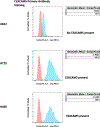Glycoprotein Receptor CEACAM5-Targeted Intraoperative Molecular Imaging Tracer in Non-Small Cell Lung Cancer
- PMID: 35644263
- PMCID: PMC9701246
- DOI: 10.1016/j.athoracsur.2022.05.019
Glycoprotein Receptor CEACAM5-Targeted Intraoperative Molecular Imaging Tracer in Non-Small Cell Lung Cancer
Abstract
Background: Intraoperative molecular imaging has emerged as a potential tool in addressing challenges faced during lung cancer surgery by localizing small lesions, ensuring negative margins, and identifying synchronous cancers. Carcinoembryonic antigen-related cell adhesion molecule 5 (CEACAM5) glycoprotein has emerged as a potential target in fluorescent labeling of non-small cell lung cancer given the high antigen density in tumor cells and absence of expression in normal parenchyma. The goal of our study was to determine whether anti-CEACAM5 targeted near-infrared fluorochrome could be a suitable target in non-small cell lung cancer.
Methods: The CEACAM5 expression was evaluated in AB-12 (known negative control), HT29 (known positive control), and H460 (non-small cell lung cancer) cell lines by polymerase chain reaction. SGM-101, a CEACAM5 antibody, coupled with a BM-104 near-infrared fluorescent tracer was evaluated with dose escalation, in vitro cellular localization, and immunofluorescence microscopy. Subsequently, in vivo validation was performed in 52 athymic nude xenografts.
Results: Polymerase chain reaction analysis demonstrated 3000x relative expression of CEACAM5 in HT-29 cells compared with AB-12. The H460 cells showed 1000x relative expression compared with AB12 (P < .05). Both HT29 and H460 cells showed tracer internalization with signal to background ratio of 4.5 (SD 0.34) whereas there was minimal uptake by AB12 cells with signal to background ratio 1.1 (SD 0.1; P < .05). There was linear fluorescence increase with increasing tracer dosing in receptor expressing cell lines. In preclinical models, HT-29 and H460 cells lines produced near-infrared fluorescence with average tumor to background ratio of 3.89 (SD 0.25) irrespective of tumor size compared with no fluorescence by AB12 tumors (P < .05). The CEACAM5 expressing tumors had excellent dye uptake compared with AB12 tumors.
Conclusions: CEACAM5 serves as a possible receptor for targeted intraoperative molecular imaging resections in lung cancer. This study sets a path for evaluation of CEACAM5 targets in future clinical trials.
Copyright © 2023 The Society of Thoracic Surgeons. Published by Elsevier Inc. All rights reserved.
Conflict of interest statement
Conflict of Interest:
AP and FC are co-founders of SurgiMab. AP and FC are employees of SurgiMab.
Figures








Comment in
-
Zeroing In on the Target.Ann Thorac Surg. 2023 Sep;116(3):641-642. doi: 10.1016/j.athoracsur.2022.05.043. Epub 2022 Jun 11. Ann Thorac Surg. 2023. PMID: 35700804 No abstract available.
References
-
- Lung Cancer Statistics | How Common is Lung Cancer n.d. https://www.cancer.org/cancer/lung-cancer/about/key-statistics.html (accessed August 15, 2020).
MeSH terms
Substances
Grants and funding
LinkOut - more resources
Full Text Sources
Medical

